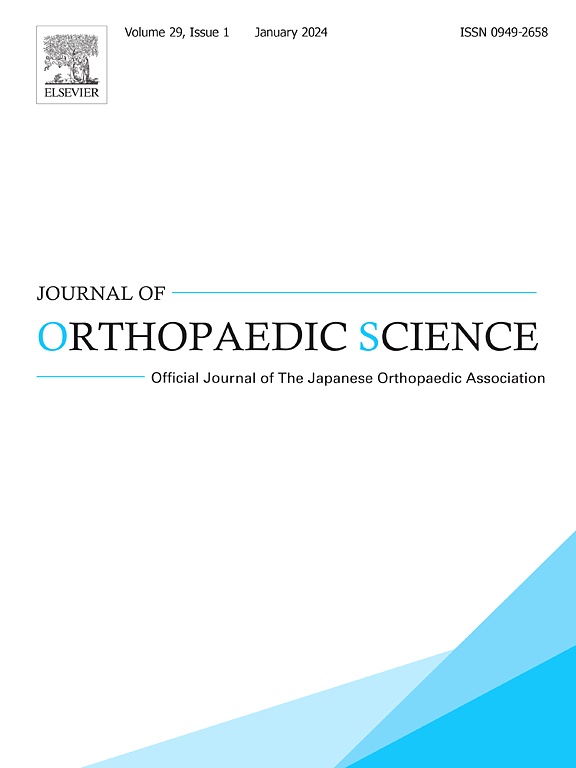
Joystick reduction benefits operative efficiency in pediatric supracondylar humeral Fx

Joystick reduction benefits operative efficiency in pediatric supracondylar humeral Fx
A comparative study of two closed reduction methods for pediatric supracondylar humeral fractures
J Orthop Sci. 2016 Sep;21(5):609-13Did you know you're eligible to earn 0.5 CME credits for reading this report? Click Here
Synopsis
68 pediatric patients with displaced supracondylar humeral fractures were randomized to one of two methods of closed reduction. In one group, if closed manipulation did not yield acceptable reduction, the joystick technique was used to facilitate reduction. In the other group, only manual traction was used for reduction. Once reduction was achieved, all patients received fracture fixation with percutaneous pinning. Results demonstrated a significantly shorter operative time, shorter fluoroscopy time, and higher reduction success rate in the joystick group compared to the manual traction group. The time to union, final radiographic outcome, and the clinical outcome did not significantly differ between groups.
Was the allocation sequence adequately generated?
Was allocation adequately concealed?
Blinding Treatment Providers: Was knowledge of the allocated interventions adequately prevented?
Blinding Outcome Assessors: Was knowledge of the allocated interventions adequately prevented?
Blinding Patients: Was knowledge of the allocated interventions adequately prevented?
Was loss to follow-up (missing outcome data) infrequent?
Are reports of the study free of suggestion of selective outcome reporting?
Were outcomes objective, patient-important and assessed in a manner to limit bias (ie. duplicate assessors, Independent assessors)?
Was the sample size sufficiently large to assure a balance of prognosis and sufficiently large number of outcome events?
Was investigator expertise/experience with both treatment and control techniques likely the same (ie.were criteria for surgeon participation/expertise provided)?
Yes = 1
Uncertain = 0.5
Not Relevant = 0
No = 0
The Reporting Criteria Assessment evaluates the transparency with which authors report the methodological and trial characteristics of the trial within the publication. The assessment is divided into five categories which are presented below.
4/4
Randomization
4/4
Outcome Measurements
2/4
Inclusion / Exclusion
4/4
Therapy Description
1/4
Statistics
Detsky AS, Naylor CD, O'Rourke K, McGeer AJ, L'Abbé KA. J Clin Epidemiol. 1992;45:255-65
The Fragility Index is a tool that aids in the interpretation of significant findings, providing a measure of strength for a result. The Fragility Index represents the number of consecutive events that need to be added to a dichotomous outcome to make the finding no longer significant. A small number represents a weaker finding and a large number represents a stronger finding.
Why was this study needed now?
Supracondylar humeral fractures are a relatively common childhood injury, usually resulting from a fall. Many of these fractures require fixation, most commonly using percutaneous pinning. Obtaining an adequate closed reduction of the fracture can be challenging with many cases converted to open reduction following failed attempts at closed reduction. The joystick technique, using either a Kirschner wire or a Shanz pin, has been reported to aid reduction, though whether there is any significant advantage of this technique over manual traction in obtaining reduction has yet to be tested in a randomized controlled trial.
What was the principal research question?
In the closed reduction of pediatric supracondylar humeral fractures, is there a significant difference in operative outcomes, including operative time, fluoroscopy time, reduction success, and postoperative radiographic outcome between reduction by joystick technique versus traditional manual traction?
What were the important findings?
- Operative time was significantly shorter in the joystick group (30.5+/-9.0min) compared to the manual traction group (48.2+/-16.4min) (p=0.000).
- Fluoroscopy time was significantly shorter in the joystick group (25.4+/-10.5s) compared to the manual traction group (55.0+/-21.2s) (p=0.000).
- The rate of failed intraoperative reduction was significantly lower in the joystick group (0/34) compared to the manual traction group (9/25) (p=0.004).
- No significant difference in the length of hospital stay was observed between the joystick group (3.0+/-1.5 days) and the manual traction group (3.2+/-1.3 days). (p=0.595).
- Time to union did not significantly differ between the joystick group (5.8+/-1.5 weeks) and the manual traction group (5.6+/-1.6 weeks) (p=0.625). Malunion occurred in four patients from each group. Nonunion was not observed in any patient in either group.
- Pin-tract infection occurred in three patients in the joystick group and two patients in the manual traction group. No other complications occurred.
- No significant difference in Flynn elbow score at final follow-up was observed between groups (p=0.664).
What should I remember most?
In the closed reduction and percutaneous pinning of pediatric supracondylar humeral fractures, closed reduction via the joystick technique significantly reduced operative time, fluoroscopy time, and improved the success rate when compared to reduction via manual traction. No significant differences in postoperative radiographic or clinical outcome were noted.
How will this affect the care of my patients?
The results of this study suggest that closed reduction with the joystick technique in percutaneous pinning of pediatric supracondylar humeral fractures may improve operative efficiency when compared to only attempting with standard manual traction. Additionally, the joystick technique for fracture reduction did not have a negative impact on the postoperative radiographic and clinical outcome when evaluated over a 2-year follow-up. Nevertheless, the current results are limited in strength by the small sample size, with large multi-center trials needed to verify these findings and further evaluate potential complications or the joystick technique.
Learn about our AI Driven
High Impact Search Feature
Our AI driven High Impact metric calculates the impact an article will have by considering both the publishing journal and the content of the article itself. Built using the latest advances in natural language processing, OE High Impact predicts an article’s future number of citations better than impact factor alone.
Continue



 LOGIN
LOGIN

Join the Conversation
Please Login or Join to leave comments.